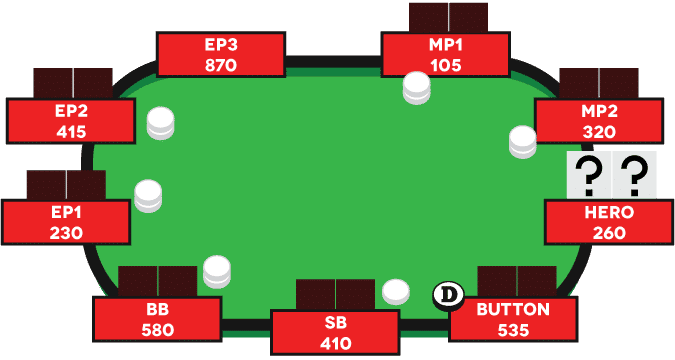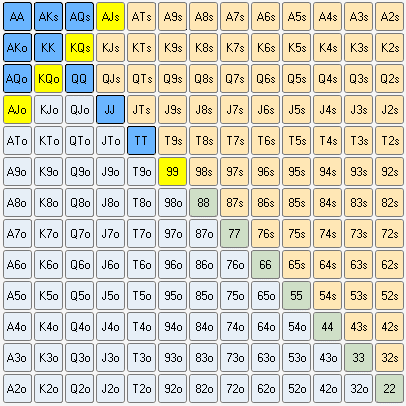We’ve all played in this game. The kind of game where every pot has a number of limpers and pots are going very multi-way. This dynamic is most common in micro limit games online and $1/$2 live games, but in reality this dynamic can occur at any stake. It’s just more common to see weaker/passive opponents in the smallest stakes, so if you play these games, these spots arise more often.
One question I get constantly about games like this is “What should I raise with against multiple limpers?” It’s a fair question, as choosing a range in a multi-way pot can be tough, so let’s do our best to answer this question and increase our profitability in this dynamic.
What should I raise with against multiple limpers?
Let’s start with a situation. You are playing $1/$2 live poker and are in the cutoff. There are 4 limps to you and it’s your action. What do your ranges look like here?

If you’ve never thought about it, this may seem daunting given the sheer number of starting hands possible. But many hands can be clumped together. T♣3♣ and 8♦4♠ can be clumped together as trash. AA and KK can be clumped together as monsters. And 6♠5♠ and 9♥8♥ can be clumped together as suited connectors. Given that, what clumps are you raising, limping, and where are the cusp hands?
Before we can give a precise answer we need to think about will happen if we raise. If we raise to $14 are we getting 1, 2, 4, or 0 callers? If we expect everyone will fold a ton of the time then does our hand matter very much? Not really, and thus we want to be attacking that situation often.
More realistically, if we raise we are probably getting 1 or more callers. And the most vital part of this is who the first limper is. Someone who is bad enough to open-limp is likely bad enough to limp/call liberally. Once one person calls your raise the players behind are going to call more often. They see a big pot brewing and they want to see if they can get lucky and smash the flop…correctly or incorrectly.
So chances are you won’t get a heads up pot when you raise here, and thus you will see many of these pots multi-way. This means the pot will be larger on the flop, the SPR will be small, and that bluff continuation betting is tougher. Whenever you enter a pot with this knowledge it implies that you want to use a strong range (barring other information). I’ll usually raise these pots with TT+/AQ+ as a pure default, and hands like AJ/KQ/99 when appropriate. This keeps my range nice and strong-weighted, which will perform best in a multi-way small SPR pot.

As a general rule, a good raising size in live games is 5x+1x/limper. So if there are 4 limpers, you’d raise 9x, or to $18. This may seem like a large size, but it’s very reasonable given the number of limpers. And if we are raising a strong range of TT+/AQ+, then we want to generate lots of value and a large size will do that. We also don’t want to go so small that everyone calls our raise. By doing that, our equity shrinks for each extra caller and we increase the chance of getting screwed…even with AA.
a good raising size in live games is 5x+1x/limper
That being said, we don’t want to go so large with a monster hand, say to $40, if we’ll never get even 1 caller. And we don’t want to go so small with a monster hand, say to $10, that everyone calls us. So with many limpers something between $20-$30 at $1/$2 is usually going to be the best size. But the exact size you choose will be based upon the exact situation. Your hand, your opponents, your position, etc.
Other influential variables include the number of limpers. The fewer limpers there are, the more hands I’m going to raise. The more limper there are, the less hands I’m going to raise. This is simply a function of how many players I can get to fold preflop, and if they don’t fold preflop, how many players would realistically see the flop. I don’t want to take K♣J♣ to war in a 5-way bloated pot with a small SPR if I can avoid it. But if I would only get a maximum of 2 callers, that K♣J♣ starts to look much better.
Another consideration is position. When I’m in-position, especially from the cutoff or button, I’m going to raise with many more hands than from the blinds. This same concept applies if I’m in MP1 and 2 players in early position limp. If I raise to say $14 in that situation will a bunch of players behind me call, thus putting me OOP in a bloated multi-way pot? If so, do I really want to find myself here with A♠T♠ or 6♣6♦? In general I want to enter pots by raising…but there are many times in multi-way pots where limping behind is a more attractive option.
These are spots where “it depends” is often times the answer, and I rarely have an exact range of hands here. I have a starting range, but as variables change (number of limpers, position, elasticity levels of my opponents, etc.), so does my range. The best poker advice is almost never to give an exact range of hands to use in each spot, rather to understand what goes into choosing a +EV range. That’s what this article gives you, now it’s up to you make sure you pay attention to other inputs during your session!


Great article!
Thanks Wooferr!
Well presented. It has to be set out with principles instead of rules since each situatuion is gonna be slightly different. Would you say this is appropriate for early stage MTT’s?
Thanks! And yes, when the effective stack sizes are deeper in MTTs this is just as appropriate imo.
What do you suggest doing in mid-late position with small/mid pocket pairs in a limp-fest pot?
I enjoy your videos and articles, Thanks.
Thanks outfit! As a default I limp them and take the cheap flop…but with any reads that a raise would get 0-1 caller I begin raising more often.
I want to title this comment:
“Limpers and Social-Norms”
First of all I want to tell you that I have learned a lot from Mr. Sweeney and from Ed Miller’s books.
I want to write about a phenomena associated with limping. I have encountered this “social norm” phenomena in my short NLHE career in the NYC cardrooms and “home games” I play in.
What I have found is this: in games where more than half the table limps more than half the time the non-limper sticks out like a sore thumb. Eventually there is a sort of consensus (unspoken, non-conspiratorial) around punishing the raiser. It is as if the raiser is violating a social norm. The more money the non-limper is making the more it seems that the social-norm must be enforced against the non-limper.
So let me say I have never been a limper simply because it didn’t make sense. I spent my poker life playing stud and the game is structured around an ante as a price of entry for your initial cards. It simply makes no sense for five players to treat the size of one Big Blind as a kind of ante to see the Flop. That is not the way Texas Hold’em is structured and it is a waste to “ante-up” with almost any range in Hold’em. That was my reasoning.
But what I soon found is that in games where limping is treated like an ante, those who never limp are eventually seen as doing something “unfriendly.” I never limp and eventually, half-way through a game, if I am winning, I am practically always re-raised by a limper if I raise, when coming into the pot.
So half-way through the night, if 3 to 5 people limp and I raise more than 60% of the time there would be a re-raise. Since I don’t play more than 84% of my hole cards this is a substantial number of re-raises. My way of dealing with it is simply to 4 bet with top 20% of my range instead of only QQ+ and AK+ which is my usual r-eraise range. It is the only way I can figure out to combat this kind of thing. Also, the more limpers the higher I try to make my first raise. Sometimes I just tighten up my initial range more.
In truth I don’t know what strategy to use against this kind of “punishment” for violating social-norms. Certainly, I should find a way to “punish” this kind of behavior myself. But what I have found that in certain cases limpers can limp with anything from 65o to AKs.
It amazes me that somebody limped in with AKs but they did.
I’m not sure if it was to trap me personally but it certainly felt that way. I said to myself, how could they set a trap for me when they didn’t even know if I would go in that hand. But what happened is that somebody from hijack limped in with AKs. I had KK on the button so he raised. I reraised and he went all in. I doubted that he had AA and limped so I went all in assuming he probably had QQ. But he had AKs. This shocked me. Bad beat and he flopped an Ace.
I still would have gone all in preflop against his hand so I am not sorry I did it.
The point here is that he limped with AKs! Why? The only thing I can figure is that he was obeying some-kind of social norm that I was violating. And he was obeying it more strictly than usual simply because I was violating it. Strange behavior, no?
Let me reply to myself. It is possible that I don’t raise enough or that I am playing too tight against limpers. As a default and as a beginning NLHE player I play pretty tight. I am older and dress tweedy, like the college teacher I sometime am, so the assumption is that I am nit. I bluff and take the pot early in sessions because of this assumption. Still I am a tight player and a bit too much of a nit I think. Raise more, and steal more? Probably. But the fact is that I know that some of these limpers are better “intuitive” players than I am. My A-game may approach being a good TAG but my b-game quickly becomes a confused fish. Late in a session the better limpers realize this. Thus the two buy-ins I build up in the first half of a session I am liable to lose late in the session if I don’t quit when I see myself become confused. In the last 6 months since I moved from very soft home-games to the card-rooms I have been doing better than I expected. I’m still not as good as I should be.
Most of these players have zero idea how to properly build a limp/re-raise range. Just do some basic analysis on your own as to what that range looks like and create a simple counter-strategy (it will likely include a lot of 4betting =) )
I feel you,im a regular at extra loose passive fishy gambler infested,live low stakes plo and holdem.Most people never fold preflop unless raised giganticaly.They just wanna see a flop.Especially in plo games,you ll see preflop pot repot repot jam call call call call all the time.Makes me wonder,why dont they try play craps instead?
I’ve experienced what happened to Jerry as well. While my micro live poker group rarely limp-3bets, all of them will flat call when I raise for the big pot and any one of them will try to steal the pot from me if no A or K comes as they see me as a tight player.
I really don’t think they are that observant but once I was tagged as a nit, they can outplay me easily so I had to adjust.
As for the 4betting adjustment, I’d love to try it but most of the stacks in my group are mid to small stacks and their 3bet is usually weighted with 99+ AK+ so I will need a hand that’s strong enough for that range
Hey James, fan of articles and videos! What do you do against 3-4 limpers (if you dont have any reads) with something like A7s, A8s. with lets say 25bb. Do you just shove or limp behind? Thanks a lot
Thanks bud! If there is FE, fire away. We also did a podcast episode about this (though more through the lens of 100bb play): https://redchippoker.com/attacking-limpers/
Where I play (L.A, area) there are lots of limpers at $1/2. It’s not unheard of to get a big bet from a decent TAG on the button, but there will always be some people who get butt-hurt over it. One of the ways I cope with that is by limping in near the back with set mines, suited connectors, and suited gappers. I know that Ed and Doug frown on this, but it’s a good way for me to get in cheap with some pretty good pre-flop odds, and I blend right in with the fish. And I’m still not at all shy about using the 5x+1x/limper formula when I have position and a hand.